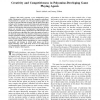Free Online Productivity Tools
i2Speak
i2Symbol
i2OCR
iTex2Img
iWeb2Print
iWeb2Shot
i2Type
iPdf2Split
iPdf2Merge
i2Bopomofo
i2Arabic
i2Style
i2Image
i2PDF
iLatex2Rtf
Sci2ools
CIG
2013
IEEE
2013
IEEE
Creativity and competitiveness in polyomino-developing game playing agents
—This study proposes a new mathematical game called Polyomination which involves the competitive placement of polyominoes to capture area. The game playing agents used are able to encode both their strategy and the game pieces they will play with. Strategy is encoded in a finite state representation called a binary decision automata which has access to a variety s of information abstracted from the game state. Playing pieces are encoded by a developmental representation. An extensive parameter study is performed. The elite-fraction used by the evolutionary algorithm that trains the agents is found to be relatively unimportant. The number of states in the automata and the maximum number of squares used to build polyominoes are found to have a significant impact on competitive ability. The polyomino playing pieces are found to evolve in a strategic manner with playing pieces specializing for area-occupation, area-denial, and cleanup in which small pieces can fill in small remaining ...
| Added | 19 May 2015 |
| Updated | 19 May 2015 |
| Type | Journal |
| Year | 2013 |
| Where | CIG |
| Authors | Daniel Ashlock, Jeremy Gilbert |
Comments (0)

